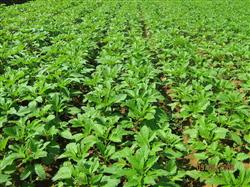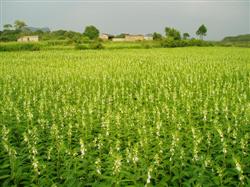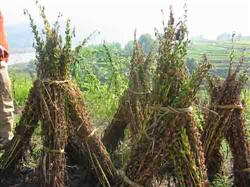How can sesame seed be fertilized with high yield?

How can sesame seed be fertilized with high yield? Please give guidance on the fertilizer requirements of high-yielding sesame. Sesame is a fertilizer-loving crop. For every 100 kg of grain, it is necessary to absorb 8-9 kg of pure nitrogen, 3 kg of phosphorus pentoxide and 7 kg of potassium oxide. At present, the yield of sesame per mu is generally 40-60 kg, and the high-yield field is generally 75-95 kg. In the early stage of growth, the seedling situation is weak, the root system is not developed, and the ability of fertilizer absorption is weak, but in the middle and later stage of growth, when the vegetative growth and reproductive growth go hand in hand, the root system also enters the flourishing period, and the amount of fertilizer is increased. If the fertility is insufficient in this period, it will lead to short plants, few flowers and pods, few seeds and low yield. Fertilization technology of high-yield sesame: applying sufficient base fertilizer. According to the survey, 80% of the fields do not apply base fertilizer or topdressing. Increasing the application of basal fertilizer is beneficial to promote the development of plant root system, growth of main root, increase of lateral root, absorption of nutrients, early development of seedling stage, increase of leaf area, enhancement of photosynthesis and setting up high-yield seedling frame. Specifically, the base fertilizer must be fully applied at one time, with 2000-2500 kg of rotten farm manure, 20-25 kg of phosphate fertilizer, 10-15 kg of potash fertilizer and 0.7-1 kg of boron fertilizer per mu. If the application of cake fertilizer 75kg 100kg and compound fertilizer 20kg 25kg, the effect of increasing yield is more significant. Apply fertilizer to seedlings. Although the amount of fertilizer required at the seedling stage is less, in the case of thin seedlings and poor growth, topdressing seedling fertilizer is very important for the cultivation of strong seedlings, multi-differentiation of flower buds, branches and later growth and development. When sesame enters the flower bud differentiation stage, the effect of topdressing quick-acting nitrogen fertilizer is the highest, generally applying urea 3kg / mu, the application amount is determined by seedling, land and weather, and seedling fertilizer is generally applied after seedling determination. Re-apply flower bud fertilizer. The flowering and capsule stage of sesame is the peak period of nutrient absorption in its life. from early flowering to full flowering, the absorption of nitrogen, phosphorus and potassium accounted for 66.2%, 55.19% and 58.37%, respectively. The re-application of flower bud fertilizer can promote the differentiation of flower buds and lay a material foundation for the large demand for nutrients at the stage of flowering and capsule formation, which can significantly increase yield and improve quality. Topdressing at flowering stage is the most suitable for budding and early flowering stage, generally applying urea 5 to 7.5 kg per mu, and then topdressing again at the flowering and capsule stage, with urea 2 to 3 kg, increasing production by 18% to 25%. Pay attention to applying fertilizer before rain or when the ground is wet after rain, apply after dry dew in sunny days, and should not be fertilized during drought, otherwise furrow irrigation must be used in time to resist drought. Do a good job of foliar spraying. According to the experiment, when potassium dihydrogen phosphate solution was sprayed twice at flowering stage, the 1000-grain weight increased by 0.09 g and the yield increased by 19%. Spraying twice, that is, it is sprayed once in the early flowering stage, and the second time every 5 days, generally using 200 kg potassium dihydrogen phosphate per mu, diluted with water 50 kg 62.5 kg, should be carried out in cloudy or sunny evening, avoid the interference of high temperature and dry-hot wind during fertilizer spraying, reduce the evaporation of water in nutrient solution, and be more beneficial to the absorption of nutrients by leaves. In addition, spraying 1000 times of 802 solution continuously at the early flowering stage of sesame could prevent premature senescence and improve the composition of sesame yield characters. For overgrown sesame, 0.01% trimethoprim solution can be sprayed once at the early flowering stage, which can inhibit the overgrowth, make the sesame stalk short and sturdy, and have a significant effect on increasing yield. Click to get more sesame planting techniques click to get more food crop planting techniques
- Prev

How to fertilize sesame seeds?
How to fertilize sesame seeds? Please give guidance to sesame fertilization can refer to the following methods: early application of seedling fertilizer sesame because the seeds are small, coupled with often the bottom application of too much nitrogen fertilizer, it is easy to make seedlings grow and form tall seedlings. Therefore, sesame should be combined with early seedling, early seedling, see seedling early application with quick-acting fertilizer.
- Next

What should we pay attention to in order to grow sesame seeds with high yield?
What should we pay attention to in order to grow sesame seeds with high yield? Please introduce the following key points for high yield of sesame seeds: after intermediate ploughing, weeding and weeding, shallow hoeing and loosening soil and weeding should be done, when the seedling height is 5 cm, the second intermediate tillage should be carried out, and then two times of intermediate ploughing should be carried out according to the soil condition and seedling condition. in order to achieve loose soil and good ventilation.
Related
- The first cup of black tea in spring, the flavor and history of tea gardens in Kenya, Africa
- The computer can not only choose potatoes, but also grow tea rice. AI will grow winter oolong tea champion.
- It is not only the inflated tea bitten by insects, but also engraved with the four seasons tea in Beipu.
- The Oriental Beauty Tea Festival in Zhuxian County takes the stage at the weekend to experience the plus-size feast of oil tea.
- & quot; Oriental Beauty Tea & Exploration of Emei in Hsinchu, the hometown of quot;
- The new variety of strawberry "Tainong 1" dessert is the first choice with mellow aroma. Crimson gorgeous
- History of Tea in Taiwan: from Wild Inner Mountain to Export Tea Garden
- Two types of Taiwan Oriental Beauty Black Tea won the British three-Star Award for Childhood Tea Xiang Zhang Jiaqi changed from pilot to champion tea maker.
- Banana species and varieties: the planting history of Taiwan Xianren banana and dwarf banana is long, is banana disease resistant?
- Coffee planting Technology: Qianjie Coffee from Seedling to harvesting

